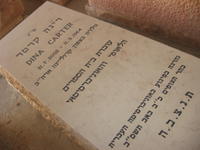From the Congress - New trends in Talmud
Professor Brody apparently presented, highly condensed (but including a joke), the basis for his belief in the "Stam kadum". I don't know the details, but I can explain the essentials. The "Stam" is the extensive anonymous portion of the Talmud, what is left when you remove all the attributed quotes from Tannaim and Amoraim. On the whole, it can be described as the cement that holds together the bricks, the "meimrot" or sayings of named figures. But very often, an entire discussion will develop without any names coming up.
In many instances, these discussions introduce concepts that were not explicit in any of the meimrot. Many critical Talmudists, and foremost among them is Prof. David Halivni, have developed the approach that all of these discussions are antecedent to the named Amoraim, and that the concepts and ideas developed in the Stam are not necessarily implied in the meimrot, or even compatible with them. This approach, which in some ways has been developed further by Prof. Shamma Friedman, has spawned innumerable studies and even a website.
Now, this approach is dynamic and evolving, and the nuances depend on the practitioner. Apparently, Halivni has become more and more sweeping in his view of the Stam as being late, later than all the Amoraim and perhaps to be identified with the mysterious Savoraim. But maybe earlier than them. In any case, always later than the Amoraim mentioned in the sugya.
Brody, generally, dislikes generalisations. And the point of his speech at the Congress was to demonstrate that, in some instances, concepts explicit in the Stam are, in fact, implicit in statements by Amoraim. Therefore, it is probable that the discussion of the Stam existed, in some form, during the lifetimes of the Amoraim. And, therefore, not all Stam is late. Hence "Stam Kadum", ancient Stam.
Leib Moscovitz gave a much less ambitious speech. He grappled with the methodological challenge of determining whether a given meimra is authentically Amoraic. Sometimes there seem to be meimrot that are entirely artificial. At other times, a meimra would seem to contain foreign elements that were added on at a later stage. He presented several different tools for answering this question - tools which he has used himself, many of which are presented by Shamma Friedman in his studies - and the shortcomings inherent in each one. His conclusion was that there is no "magic bullet", and at the end of the day, a scholar must revert to his own intuition.
I have not heard enough about the speeches by Kalmin and Elman to present them here. Apparently, there was a feeling that it would have been appropriate to allow Friedman and Halivni, both of whom were present at the session, an opportunity to respond to their critics. But there was not enough time, and such an opportunity had not been anticipated.
From what I have heard, this session, though not officially devoted to any specific approach in scholarship, was a testimony, even if a partially critical one, to the extent to which Halivni and Friedman have left their mark on Talmudic studies. And it is a cause for happiness that they are both still with us, continuing to contribute and to think.








